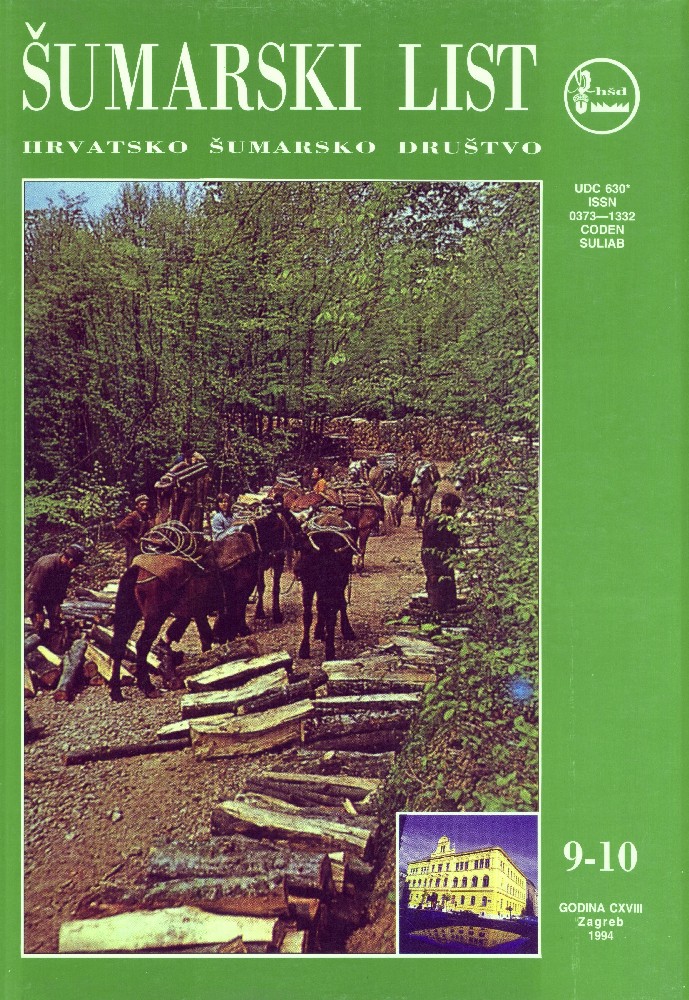
broj: 9-10/1994
pdf (13,1 MB) |
|
||||||||||||||
| IZVORNI ZNANSTVENI ČLANCI | ||
| Bojanin, S., Krpan, A. P. B. | UDK 630* 323+37.001/2 | |
| Exploitation of Forests in Different Working Conditions in Croatia pdf HR EN | 271 | |
| PRETHODNO PRIOPĆENJE | ||
| Prpić, B., Seletković, Z., Vukelić, J. | UDK 630* 425.+502.7(497.13) | |
| Application of Systematic Research of Forest Dieback So Far in the Assessment of Chemical Loading of Neighbouring Agricultural Areas in Croatia pdf HR EN | 283 | |
| PREGLEDNI ČLANCI | ||
| Rauš, Đ. | UDK 630* 182.3+502.7.002 | |
| Application of Phytocenology in Silvicultural Practice pdf HR EN | 289 | |
| STRUČNI ČLANCI | ||
| Đurasović, P. | UDK 630* 271.+49 (Trsteno) | |
| Domage to Vegetation and Restoration of Vegetation in the Arboretum Trsteno caused by the Great Fire in 1991. pdf HR EN | 295 | |
| Summary: The Arboretum Trsteno of the Croatian Academy od Sciences and Arts is one of the best known arboreta in Europa and in the world. It is located near Dubrovnik in a place called Trsteno, and covers an area of 25,513 ha. It was founded in the 15th century by an old aristocratic family Gučetić — Gozze. It is well known as an old Gothic-Renaissance garden, belonging to Dubrovnik, with a famous collection of exotic trees and shrubs, amounting to more than 300 species. At the beginning of October 1991, at the time of the Serbian imperialistic aggression on Croatia, the Serbo-Yugoslav Army burned down the Arboretum Trsteno by incendiary shells fired from war-ships anchored at Brsečin and by dropping inflammable substances — phosphorus from combat planes flying close to the ground above the Arboretum Trsteno. In this disasterous fire on the 2nd and 3rd October 1991 approximately 80% of the Trsteno Arboretum vegetation was destroyed. The old pravillion, in front of the Gučetić´ summer residence, greenhouse and arboretum´s garden nurseries, were also completely burned down to the foundations. More than 10,000 trees were destroyed in the fire, which included 8,000 Aleppo Pine (Pinus halepensis Mill.), about 2,000 cypresses (Cupressus sempervirens L.), 100 Brutian Pine trees (Pinus brutia Ten.) 100 trees of Maritime Pine (Pinus pinaster Ait.), and 100 trees of Dalmatian Black Pine (Pinus nigra ssp. dalmatica (Vis. I Schwz.). Of the remaining trees 100 olive trees were also destroyed in the fire (Olea europaea L. ssp. europaea), 30 citrus fruit trees (Citrus sp.) and 20 windmill palm trees (Trachycarpus fortunei /Hook./ H. Wendl.). In the same way 200 species of young exotic plants were destroyed, older than 3—5 years, which had been cultivated for the purpose of planting exotic trees and shrubs in the Arboretum Trsteno. In this great fire and as an result of the Serbian occupation of Trsteno Arboretum, from the end of October 1991 to the end of May 1992, 30 exotic plant species were destroyed by fire or dieback, which amounts to 10% of the total number of exotic species of trees and shrubs. The following species of exotic trees and shrubs disappeared: several species of eucalypti (Eucalyptus sp.), Colorado Fir (Abies cocnolor IGord. et Glend.l Lindl ex Hildebr.), senna trees (Cassia tora I Cassia corymbosa Lam.), quite a number of acacia (Acacia decipiens I Acacia dietrichianaj Acacia doratoxylon Cunn., I Acacia karoo, I Acacia pychnantha Benth., I Acacia saligna), Albizzia (Albizia lophantha I Willd.), a few species of Rhododendrons (Rhododendron sp.), African Rose (Colutea arborescens L.), Ivy (Hedera helix var. sagitaeffolia), Pyrophoric Shrub (Pyracantha rogersiana I Jacks. I Bean), Cneorum tricoccon L., kasuarina (Casuarina torulosa Dryand.), Hakea laufina R. Br., Montinia caryophyllacea, papaya (Carica papaya L.), Carica quercifolia, Ampelopsis aconitifolia (Bunge), Oregon Grape (Ilex aquifolium I Pursh. I Nutt.), Sarcoccoca ruscifolia Stapf. The following species of more important half-shrubs and perennial plants which disappeared are: evergreen (Vinca rosea), Japanese decorative banana — tree (Musa basjoo Sieb. et Zucc. ex Limuna) and Artichoke (Cynara scolymus L,). Restoration of the Arboretum Trsteno vegetation is planned to take place by both natural regeneration and artificially. By counting the annual rings and the burned and larger dimension Aleppo Pine trees, the age of the destroyed pine forest was determined to be 80 years. On site examination confirmed intensive natural regeneration of Aleppo Pine (Pinus halepensis Mill.). For natural reforestation of the Aleppo Pine, i.e. for trees to reach up to 80—100 cm diameter breast height, as prior to the fire, will take approximately 80 years. The time needed in order to cultivate an exotic plant to achieve dimension of between 50—80 cm DBH is also approximately 80 years. In order to repair damage and restore the vegetation which perished in this disasterous fire on the 2nd and 3rd October 1991, caused by the Serbian- Yugoslav army, and to eliminate the damage inflicted by the Serbian occupation of the Trsteno Arboretum from the end of October 1991 until the end of may 1992, will take approximately 80 years in order to regenerate the old natural stands of Allepo Pine, to cultivate the exotic plants, and to reestablish the basic vegetation of the Trsteno Arboretum to the original state as it was prior to the big fire of 1991. | ||
| Čop, B. | UDK 630* 323:674. | |
| The Influence of Forestry on business operations and Development of Primary Conversion of Wood pdf HR EN | 305 | |
| Piškorić, O. | UDK 630* 903 | |
| The Forests of Austia, Chile, France and Poland pdf HR EN | 311 | |


